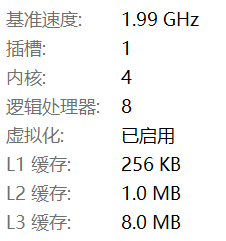CPU使用率原理及计算方式
本文转载自CPU使用率原理及计算方式
CPU:超线程和多核
超线程(Hyper-Threading )
超线程是Intel最早提出一项技术,最早出现在2002年的Pentium4上。单个采用超线程的CPU对于操作系统来说就像有两个逻辑CPU,为此P4处理器需要多加入一个Logical CPU Pointer(逻辑处理单元)。
虽然采用超线程技术能同时执行两个线程,但它并不像两个真正的CPU那样,每个CPU都具有独立的资源。当两个线程都同时需要某一个资源时,其中一个要暂时停止,并让出资源,直到这些资源闲置后才能继续。因此超线程的性能并不等于两颗CPU的性能。
多核(multi-cores)
最开始CPU只有一个核(core),为了提高性能,引入了双核CPU,四核CPU等,双核CPU能同时执行两个线程。和超线程不同的是,双核CPU是实打实的有两个central processing units在一个CPU chip。

上图显示主板上有1个插槽(socket),这个插槽插着一个CPU,这个CPU有4个核(core),每个核都使用超线程技术,所以这台机器总共有8个逻辑核。
CPU使用率计算
CPU使用率测试
一台拥有8个logic core CPU的机器,执行如下程序:
#include <pthread.h>
const int num = 9;
pthread_t threads[num];
void *func(void* arg) {
while(1) {}
return ((void *)0);
}
int main(int argc, char* argv[]) {
for (int i = 0; i < num; i++) {
pthread_create(&threads[i], NULL, func, NULL);
}
for (int i = 0; i < num; i++) {
pthread_join(threads[i], NULL);
}
return 0;
}
该程序开启9个线程每个线程都执行一个死循环。执行后用top查看cpu使用情况:
332 root 20 0 84312 612 416 S 800.0 0.0 7:18.41 cputest
可以看到cputest的CPU使用情况为800%,也就是8个logic core都在执行cputest这个进程。
而在一个只有1个logic的CPU上跑的结果如下:
13812 ubuntu 20 0 80284 708 628 S 97.7 0.1 0:10.14 cputest
可以看到,纵使开启了9个线程,每个线程都执行死循环,CPU使用率只有97.7%。
如何计算CPU使用率
1. %CPU -- CPU Usage
The task's share of the elapsed CPU time since the last screen update, expressed as a percentage of total CPU time.
In a true SMP environment, if a process is multi-threaded and top is not operating in Threads mode, amounts greater than 100% may be reported. You toggle
Threads mode with the `H' interactive command.
Also for multi-processor environments, if Irix mode is Off, top will operate in Solaris mode where a task's cpu usage will be divided by the total number
of CPUs. You toggle Irix/Solaris modes with the `I' interactive command.
以上截取自man top中对于CPU使用率的定义,总结来说某个进程的CPU使用率就是这个进程在一段时间内占用的CPU时间占总的CPU时间的百分比。
比如某个开启多线程的进程1s内占用了CPU0 0.6s, CPU1 0.9s, 那么它的占用率是150%。这样就不难理解上例中cputest进程CPU占用率为800%这个结果了。
实现CPU使用率统计程序
原理
某进程cpu使用率 = 该进程cpu时间 / 总cpu时间。
/proc/pid/stat中可以得出进程自启动以来占用的cpu时间。以bash进程为例:
79 (bash) S 46 79 79 34816 0 0 0 0 0 0 46 135 387954 4807 20 0 1 0 6114 232049254400 873 18446744073709551615 0 0 0 0 0 0 0 0 0 0 0 0 0 0 0 0 0 0 0 0 0 0 0 0 0 0 0
第14项utime和第15项stime分别表示bash自启动起来,执行用户代码态占用的时间和执行内核态代码占用的时间,单位是clock tick,clock tick是时间单位。这两项的详细解释如下(摘自man proc):
(14) utime %lu
Amount of time that this process has been scheduled in user mode, measured in clock ticks (divide by sysconf(_SC_CLK_TCK)). This includes
guest time, guest_time (time spent running a virtual CPU, see below), so that applications that are not aware of the guest time field do not
lose that time from their calculations.
(15) stime %lu
Amount of time that this process has been scheduled in kernel mode, measured in clock ticks (divide by sysconf(_SC_CLK_TCK)).
每个clock tick占用多少时间呢?
可以通过sysconf(_SC_CLK_TCK)获取1秒内有多少个clock tick(通常是100)。也就是说1 clock tick为1 / 100秒。
实现
有了上面的基础,
我们可以每隔period秒读取/proc/pid/stat,解析其中的utime和stime,将其和(utime+stime)减去上一次采样时这两项的和(lastutime + laststime),这就是period秒内该进程占用CPU的时间,单位为clock tick。
总的CPU时间为period * sysconf(_SC_CLK_TCK),单位也为clock tick。
所以公式如下:
某进程cpu使用率 = ((utime+stime) - (lastutime + laststime)) / (period * sysconf(_SC_CLK_TCK))
以下是实现:
#include <unistd.h>
#include <stdio.h>
#include <sys/time.h>
#include <string.h>
#include <signal.h>
#include <stdlib.h>
#include <fstream>
#include <iostream>
#include <sstream>
using namespace std;
struct StatData
{
void parse(const string& content)
{
size_t rp = content.rfind(')');
std::istringstream iss(content.data() + rp + 1);
// 0 1 2 3 4 5 6 7 8 9 11 13 15
// 3770 (cat) R 3718 3770 3718 34818 3770 4202496 214 0 0 0 0 0 0 0 20
// 16 18 19 20 21 22 23 24 25
// 0 1 0 298215 5750784 81 18446744073709551615 4194304 4242836 140736345340592
// 26
// 140736066274232 140575670169216 0 0 0 0 0 0 0 17 0 0 0 0 0 0
iss >> state;
iss >> ppid >> pgrp >> session >> tty_nr >> tpgid >> flags;
iss >> minflt >> cminflt >> majflt >> cmajflt;
iss >> utime >> stime >> cutime >> cstime;
iss >> priority >> nice >> num_threads >> itrealvalue >> starttime;
}
string name;
char state;
int ppid;
int pgrp;
int session;
int tty_nr;
int tpgid;
int flags;
long minflt;
long cminflt;
long majflt;
long cmajflt;
long utime;
long stime;
long cutime;
long cstime;
long priority;
long nice;
long num_threads;
long itrealvalue;
long starttime;
};
int clockTicks = static_cast<int>(::sysconf(_SC_CLK_TCK));
const int period = 2;
int pid;
int ticks;
StatData lastStatData;
bool processExists(pid_t pid)
{
char filename[256];
snprintf(filename, sizeof filename, "/proc/%d/stat", pid);
return ::access(filename, R_OK) == 0;
}
//read /proc/pid/stat
string readProcFile(int pid) {
char filename[256];
snprintf(filename, sizeof filename, "/proc/%d/stat", pid);
ifstream in;
in.open(filename);
stringstream ss;
ss << in.rdbuf();
string ret = ss.str();
return ret;
}
double cpuUsage(int userTicks, int sysTicks, double kPeriod, double kClockTicksPerSecond)
{
return (userTicks + sysTicks) / (kClockTicksPerSecond * kPeriod); //CPU使用率计算
}
void tick(int num) {
string content = readProcFile(pid);
StatData statData;
memset(&statData, 0, sizeof statData);
statData.parse(content);
if (ticks > 0) {
int userTicks = std::max(0, static_cast<int>(statData.utime - lastStatData.utime));
int sysTicks = std::max(0, static_cast<int>(statData.stime - lastStatData.stime));
printf("pid %d cpu usage:%.1f%%\n", pid, cpuUsage(userTicks, sysTicks, period, clockTicks) * 100);
}
ticks++;
lastStatData = statData;
}
int main(int argc, char* argv[]) {
if (argc < 2) {
printf("Usage: %s pid\n", argv[0]);
return 0;
}
pid = atoi(argv[1]);
if (!processExists(pid)) {
printf("Process %d doesn't exist.\n", pid);
return 1;
}
if (signal(SIGALRM, tick) == SIG_ERR) {
exit(0);
}
struct itimerval tick;
memset(&tick, 0, sizeof tick);
tick.it_value.tv_sec = period;
tick.it_value.tv_usec = 0;
tick.it_interval.tv_sec = period;
tick.it_interval.tv_usec = 0;
setitimer(ITIMER_REAL, &tick, NULL);
while (1) {
pause();
}
return 0;
}
代码很简单,每隔两秒采一次样,计算这两秒内指定进程的CPU使用率。
为了测试,先将前文的cputest运行起来,该程序会占满8个logic core。
./cputest &,然后top看下CPU使用率,大约占用了800%的CPU。
867 root 20 0 84312 616 416 S 800.0 0.0 17:44.60 cputest
接着用我们的自己的写的程序看下,pid是867,
./cpumon 867
pid 867 cpu usage:786.0%
pid 867 cpu usage:785.5%
pid 867 cpu usage:787.5%
pid 867 cpu usage:759.5%
pid 867 cpu usage:781.5%
pid 867 cpu usage:791.5%
pid 867 cpu usage:743.5%
pid 867 cpu usage:782.0%
pid 867 cpu usage:777.5%
pid 867 cpu usage:785.0%
pid 867 cpu usage:790.5%
pid 867 cpu usage:786.0%
^C
可以看到每隔两秒都会计算一次,使用率略低于800%,也可以理解,因为现在cpumon也会占用一定的CPU时间。
参考资料:
CPU Basics: Multiple CPUs, Cores, and Hyper-Threading Explained


